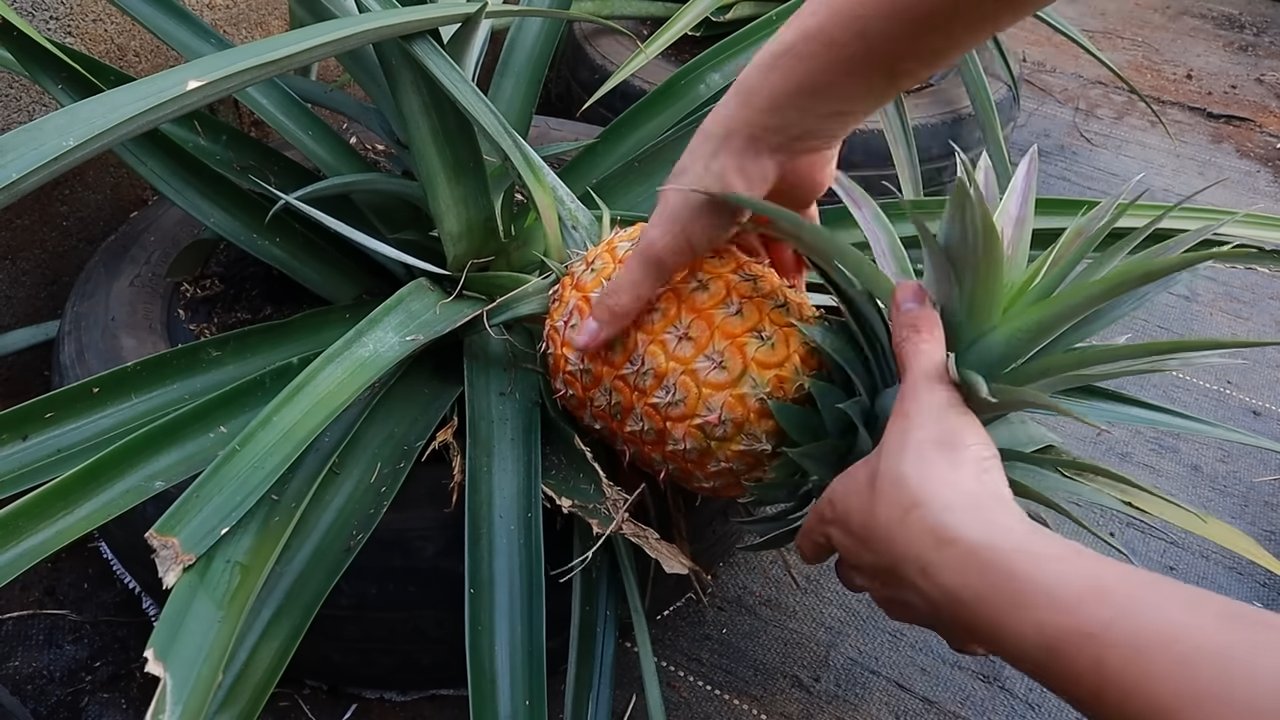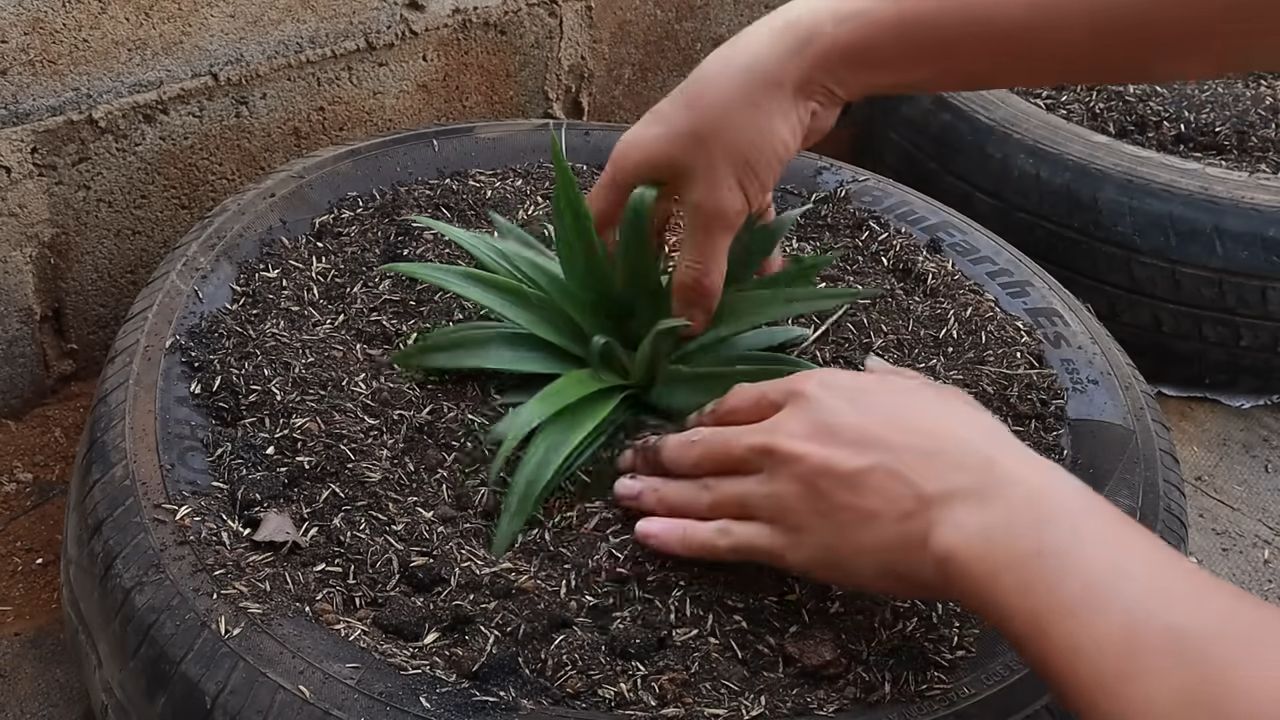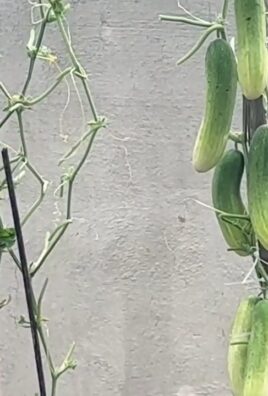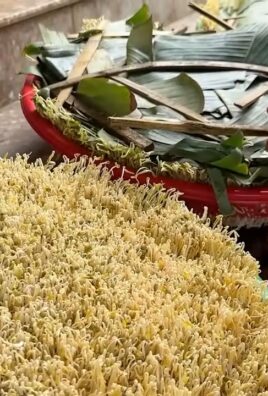Terrace Pineapple Growing Tips: Ever dreamt of sipping a homegrown pineapple cocktail on your very own terrace? I know I have! There’s something incredibly satisfying about nurturing a plant from a humble start to a juicy, tropical treat. But let’s be honest, the thought of growing pineapples, especially on a terrace, can seem a little daunting.
Pineapples, with their spiky crowns and sweet, tangy flesh, have a rich history. Originating in South America, they were a symbol of hospitality and luxury, often displayed at feasts and even rented out as decorative centerpieces! Now, you can bring that touch of tropical elegance to your own home.
Why should you try these terrace pineapple growing tips? Well, for starters, it’s a fantastic way to add a unique and vibrant element to your outdoor space. More importantly, growing your own food is incredibly rewarding. You know exactly what goes into your pineapple, avoiding any unwanted chemicals or pesticides. Plus, imagine the bragging rights! This DIY guide will break down the process into simple, manageable steps, ensuring even beginners can enjoy the fruits (pun intended!) of their labor. So, grab your gardening gloves, and let’s get started on this exciting pineapple adventure!

Growing Pineapples on Your Terrace: A Tropical Escape at Home!
Hey there, fellow plant enthusiasts! Ever dreamt of sipping on a freshly grown pineapple, right from your own terrace? Well, dream no more! I’m here to guide you through the surprisingly simple process of growing these tropical delights in containers. It’s easier than you think, and the reward is oh-so-sweet. Let’s get started!
What You’ll Need: The Pineapple Growing Arsenal
Before we dive in, let’s gather our supplies. Here’s what you’ll need to transform your terrace into a mini-pineapple plantation:
* A Pineapple Top: This is the star of the show! Choose a ripe pineapple from the grocery store. Look for one with healthy, green leaves.
* A Sharp Knife: For cleanly removing the top.
* A Large Container: At least 12 inches in diameter and depth. Pineapples need room to grow.
* Well-Draining Potting Mix: A mix designed for cacti or succulents works great. Good drainage is crucial!
* Rooting Hormone (Optional): This can speed up the rooting process, but it’s not essential.
* Watering Can or Hose: For keeping your pineapple happy and hydrated.
* Fertilizer: A balanced, slow-release fertilizer is ideal.
* Gloves: To protect your hands.
* Patience: Growing pineapples takes time, so be prepared to wait!
Preparing the Pineapple Top: Setting the Stage for Success
This is a crucial step, so pay close attention! We need to prepare the pineapple top to encourage root growth.
1. Twist and Remove (or Cut): The easiest way is to firmly grasp the leaves and twist the top off the pineapple. If that doesn’t work, use your sharp knife to carefully cut the top off, leaving about an inch of fruit attached.
2. Remove the Fruit Flesh: This is important to prevent rotting. Carefully remove any remaining fruit flesh from the base of the pineapple top. You can use your knife to gently scrape it away. Be careful not to damage the base where the roots will emerge.
3. Peel Back the Lower Leaves: Peel off several layers of the lower leaves until you expose about an inch or two of the stem. This will reveal the root nodes, where the roots will eventually sprout.
4. Let it Dry (Curing): This is a vital step to prevent rot. Place the pineapple top in a cool, dry place for about a week. This allows the cut end to callous over, reducing the risk of fungal infections. I usually leave mine on a paper towel in my garage.
Planting Your Pineapple Top: From Top to Tropical Treasure
Now for the fun part – planting!
1. Prepare the Container: Fill your container with the well-draining potting mix, leaving a few inches of space at the top.
2. Make a Hole: Create a hole in the center of the potting mix that’s large enough to accommodate the pineapple top.
3. Apply Rooting Hormone (Optional): If you’re using rooting hormone, dip the base of the pineapple top into the powder.
4. Plant the Top: Carefully place the pineapple top into the hole, ensuring that the base is buried in the soil and the leaves are above the surface.
5. Firm the Soil: Gently firm the soil around the pineapple top to provide support.
6. Water Thoroughly: Water the soil until it’s evenly moist, but not soggy.
Caring for Your Pineapple Plant: Nurturing Your Tropical Gem
Now that your pineapple is planted, it’s time to provide the care it needs to thrive.
1. Sunlight: Pineapples love sunlight! Place your container in a location that receives at least 6 hours of direct sunlight per day. A south-facing terrace is ideal.
2. Watering: Water your pineapple plant regularly, especially during the growing season (spring and summer). Allow the soil to dry out slightly between waterings. Overwatering can lead to root rot, so be careful! I usually check the soil moisture with my finger. If the top inch feels dry, it’s time to water.
3. Fertilizing: Feed your pineapple plant with a balanced, slow-release fertilizer every 2-3 months during the growing season. Follow the instructions on the fertilizer package. You can also use a liquid fertilizer diluted to half strength every few weeks.
4. Temperature: Pineapples thrive in warm temperatures, ideally between 65°F and 85°F (18°C and 29°C). Protect your plant from frost and freezing temperatures. If you live in a colder climate, you may need to bring your pineapple plant indoors during the winter.
5. Humidity: Pineapples appreciate humidity. If you live in a dry climate, you can increase the humidity around your plant by misting it regularly with water or placing a tray of water near the container.
6. Pest Control: Keep an eye out for pests such as mealybugs and scale. If you notice any pests, treat them with insecticidal soap or neem oil.
Encouraging Fruiting: The Patience Game
This is where the real test of patience comes in. It can take anywhere from 1 to 3 years for a pineapple plant to produce fruit. But don’t worry, it’s worth the wait!
1. Maturity: Your pineapple plant needs to be mature enough to produce fruit. This typically happens when the plant is about 2-3 years old.
2. Ethephon Treatment (Optional): If you’re impatient (like me!), you can try to induce fruiting with ethephon, a plant hormone. However, this is not always successful and can damage the plant if used incorrectly. I wouldn’t recommend it for beginners.
3. Apple Trick (My Preferred Method): A safer and more natural method is to place a ripe apple core near the base of the plant and cover the entire plant with a clear plastic bag for a week. The apple releases ethylene gas, which can stimulate flowering. Make sure the bag doesn’t touch the leaves directly to avoid condensation issues.
4. Observe and Wait: After the flowering process is initiated, it will take several months for the pineapple fruit to develop. Be patient and continue to provide proper care.
Harvesting Your Pineapple: The Sweet Reward
Finally, the moment you’ve been waiting for!
1. Ripeness Indicators: A ripe pineapple will have a fragrant aroma and a slightly soft feel. The color will also change from green to yellow or golden.
2. Harvesting: Use a sharp knife to cut the pineapple from the plant. Leave a few inches of stem attached.
3. Enjoy! Now it’s time to savor the fruits (literally!) of your labor. Enjoy your homegrown pineapple fresh, grilled, or in your favorite tropical recipes.
Troubleshooting: Addressing Common Pineapple Problems
Even with the best care, you might encounter some challenges along the way. Here are some common problems and how to address them:
* Yellowing Leaves: This could be a sign of overwatering, underwatering, or nutrient deficiency. Adjust your watering schedule and fertilize your plant if necessary.
* Root Rot: This is caused by overwatering and poor drainage. Make sure your potting mix is well-draining and avoid overwatering. If you suspect root rot, repot your plant in fresh soil.
* Lack of Fruiting: As mentioned earlier, it can take a long time for a pineapple plant to fruit. Be patient and try the apple trick to encourage flowering.
* Pests: Keep an eye out for pests and treat them promptly with insecticidal soap or neem oil.
Terrace Pineapple Growing: My Personal Tips and Tricks
Over the years, I’ve learned a few extra tricks that have helped me grow successful pineapples on my terrace:
* Rotate Your Plant: Rotate your pineapple plant regularly to ensure that all sides receive equal sunlight.
* Use Rainwater: Pineapples prefer slightly acidic water. If possible, use rainwater to water your plant.
* Mulch: Apply a layer of mulch around the base of the plant to help retain moisture and suppress weeds.
* Don’t Give Up! Growing pineapples takes time and patience. Don’t be discouraged if you don’t see results immediately. Keep providing proper care, and you’ll eventually be rewarded with a delicious homegrown pineapple.
Growing pineapples on your terrace is a rewarding and enjoyable experience. With a little patience and care, you can transform your outdoor space into a tropical paradise and enjoy the taste of homegrown goodness. Happy growing!

Conclusion
So, there you have it! Transforming your terrace into a mini-tropical paradise with your very own homegrown pineapples is not just a whimsical dream, but a tangible reality. We’ve walked you through the essential steps, from selecting the perfect pineapple top to nurturing it into a fruit-bearing plant. But why should you embark on this journey of DIY pineapple cultivation?
Firstly, the taste. Forget the store-bought variety that often lacks the vibrant sweetness and tangy zest of a truly ripe pineapple. A terrace-grown pineapple, ripened under the sun’s golden rays, offers an unparalleled flavor explosion that will tantalize your taste buds. Imagine the satisfaction of slicing into a juicy, golden pineapple that you nurtured from a simple discarded top. It’s a taste of accomplishment, a taste of nature’s bounty, and a taste that simply cannot be replicated.
Secondly, the sustainability aspect. By growing your own pineapples, you’re reducing your carbon footprint associated with transportation and commercial farming practices. You’re also minimizing waste by repurposing a pineapple top that would otherwise end up in the trash. It’s a small step towards a greener lifestyle, a conscious choice to connect with nature, and a rewarding experience that aligns with eco-friendly principles.
Thirdly, the sheer joy of gardening. There’s something inherently therapeutic about nurturing a plant, watching it grow, and witnessing the miracle of life unfold before your eyes. Growing pineapples on your terrace provides a unique opportunity to engage with nature, de-stress from the daily grind, and cultivate a sense of accomplishment. It’s a hobby that nourishes the soul, a pastime that connects you to the earth, and a rewarding experience that brings joy and satisfaction.
But the possibilities don’t end there! Feel free to experiment with different varieties of pineapples. Perhaps you’d like to try growing a smaller, sweeter variety like the Sugarloaf pineapple, or a more exotic type like the Red Spanish pineapple. You can also explore different potting mixes to find the one that best suits your climate and growing conditions. Consider adding companion plants like basil or marigolds to deter pests and enhance the overall health of your pineapple plants.
For those living in cooler climates, consider bringing your pineapple plant indoors during the winter months. A sunny windowsill or a grow light can provide the necessary warmth and light to keep your plant thriving. You can also experiment with different fertilization techniques to optimize growth and fruit production.
Don’t be afraid to get creative and personalize your pineapple-growing experience. The beauty of DIY lies in the freedom to experiment, learn, and adapt to your unique circumstances.
We wholeheartedly encourage you to try this DIY trick and transform your terrace into a pineapple paradise. It’s a rewarding experience that combines the joy of gardening, the satisfaction of growing your own food, and the opportunity to connect with nature.
And most importantly, we want to hear about your experiences! Share your photos, tips, and stories with us. Let us know what worked for you, what challenges you faced, and what delicious pineapple creations you’ve concocted. Together, we can create a community of passionate pineapple growers and inspire others to embark on this exciting journey. So, grab a pineapple top, get your hands dirty, and let the pineapple-growing adventure begin! This method of terrace pineapple growing is sure to bring you joy.
Frequently Asked Questions (FAQ)
How long does it take to grow a pineapple from a top?
Growing a pineapple from a top is a patience game! It typically takes anywhere from 2 to 3 years for a pineapple plant to mature and produce fruit. The exact timeframe depends on several factors, including the variety of pineapple, the climate, the quality of the soil, and the amount of sunlight the plant receives. Don’t get discouraged if you don’t see fruit right away. Consistent care and attention will eventually reward you with a delicious homegrown pineapple.
What kind of soil is best for growing pineapples?
Pineapples thrive in well-draining, slightly acidic soil. A mixture of equal parts potting soil, perlite, and peat moss is a good starting point. The perlite ensures good drainage, while the peat moss helps retain moisture and provides acidity. You can also amend the soil with compost or other organic matter to improve its fertility. Avoid heavy clay soils, as they can retain too much water and lead to root rot.
How often should I water my pineapple plant?
Water your pineapple plant regularly, especially during the growing season (spring and summer). Water deeply whenever the top inch of soil feels dry to the touch. Avoid overwatering, as this can lead to root rot. In the winter, reduce watering frequency as the plant’s growth slows down. Ensure the pot has drainage holes to prevent water from accumulating at the bottom.
How much sunlight does a pineapple plant need?
Pineapples need plenty of sunlight to thrive. Aim for at least 6 hours of direct sunlight per day. If you’re growing your pineapple plant indoors, place it near a sunny window or use a grow light to supplement natural light. Insufficient sunlight can lead to stunted growth and reduced fruit production.
Do I need to fertilize my pineapple plant?
Yes, fertilizing your pineapple plant is essential for healthy growth and fruit production. Use a balanced fertilizer (e.g., 10-10-10) diluted to half strength. Fertilize every 2-3 months during the growing season. You can also use a foliar spray fertilizer to provide additional nutrients directly to the leaves. Avoid over-fertilizing, as this can damage the plant.
How do I know when my pineapple is ripe?
Determining when a pineapple is ripe can be tricky, but there are a few telltale signs. The pineapple should have a vibrant golden-yellow color, and the eyes (the individual segments of the fruit) should be relatively flat. The pineapple should also have a sweet, fragrant aroma. You can also gently tug on one of the leaves; if it comes off easily, the pineapple is likely ripe.
Can I grow pineapples indoors?
Yes, you can grow pineapples indoors, especially if you live in a cooler climate. Provide your pineapple plant with plenty of sunlight (or a grow light), well-draining soil, and regular watering. Ensure the plant has good air circulation to prevent fungal diseases. You may need to hand-pollinate the flowers to encourage fruit production.
What are some common pests and diseases that affect pineapple plants?
Common pests that can affect pineapple plants include mealybugs, scale insects, and spider mites. These pests can be controlled with insecticidal soap or neem oil. Root rot is a common disease that can affect pineapple plants, especially if they are overwatered. To prevent root rot, ensure the soil is well-draining and avoid overwatering.
Can I grow multiple pineapples in the same pot?
It’s generally best to grow each pineapple plant in its own pot. This allows the plant to have adequate space for its roots to grow and prevents competition for nutrients. If you’re growing multiple pineapple plants, make sure to space them adequately to allow for good air circulation and sunlight penetration.
What do I do with the pineapple plant after harvesting the fruit?
After harvesting the pineapple, the mother plant will eventually die. However, it will often produce “pups” or “suckers” at the base of the plant. These pups can be separated from the mother plant and replanted to grow new pineapple plants. This allows you to continue growing pineapples from the same plant for years to come.




Leave a Comment